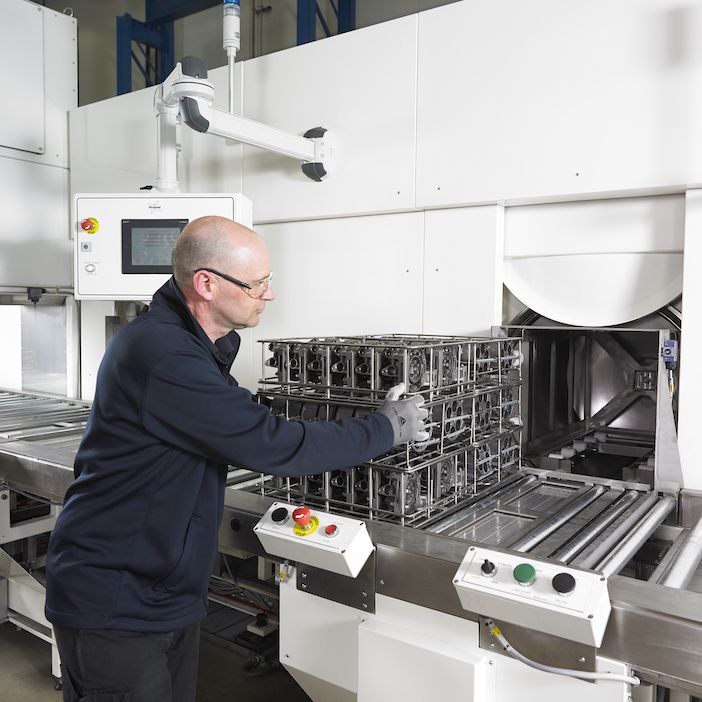Words by Dr Mark Cross, commercial sales director from Ultraseal International Group, talks about how additive printing consultancy Graphite AM overcame the issue of porosity in additive manufacturing in this case study.
Additive manufacturing is revolutionizing manufacturing in a number of industries, yet it is still subject to porosity, a well-known challenge that causes leak paths and can lead to high value components being scrapped.
Additive manufacturing (AM) enables the fast and cost-effective production of complex high-quality components in a range of materials. The rise of this technology has been fast, and it is rapidly altering the manufacturing landscape.
According to Deloitte, additive manufacturing is empowering industry 4.0. In 2019, the global additive manufacturing market size was valued at US$11.58 billion and is predicted to grow at a CAGR (compound annual growth rate) exceeding 14% from 2020 to 2027 (GVR).
AM has evolved from a revolutionary technology into a mainstream process and is now being used across a wide range of industries. From aerospace relying on additive manufacturing for functional aircraft components to automotive using it for grips, jigs and fixtures, it has seen a significant growth in applications and it’s easy to see why.
Thanks to its clean and simple process, AM produces high quality components and removes the need for expensive tooling and machining. Additive manufacturing is not only ideal for small and intricate parts, but it is also a cost-effective and quick way to produce prototypes, one-offs and components in low volumes.
A pinhole porosity problem
However, as the manufacturing technology evolves, a legacy challenge still remains: porosity. During additive manufacturing, microscopic holes that are invisible to the naked eye are formed within the body of the part. Porosity is an inherent issue with diecast components and while the cause and application might be different, the end result is always the same – and that is scrappage.
Typically, porosity is caused either by the printing process itself, or by the powder used in the process. These microscopic voids reduce the density of components, leading to cracks, leaks and fatigue. For parts that go into applications which need to be air or fluid tight – for example in fuel or cooling systems – this can be an especially critical issue.
Vacuum impregnation – a sealing solution
One way that additive manufacturing businesses can reduce the cost, waste and productivity impact of porosity is by working with porosity sealing experts who have a solution – vacuum impregnation. This process prevents gases and fluids from leaking through a component by sealing any voids with a chemically and thermally resistant polymer sealant.
UK-based 3D printing consultancy, Graphite AM wanted to ensure their customers were getting the best product quality and recognized they needed to pair with a porosity sealing partner in order to do so. They chose to partner with Ultraseal International, a global supplier in the development, manufacture and supply of porosity sealing chemicals, impregnation equipment and services.
Porosity sealing for complex components
Specializing in complex designs and high-performance components in tailored materials, Graphite AM primarily uses SLS (selective laser sintering), an AM process which deploys lasers to sinter powdered material, binding it together to create a solid structure.
While the majority of bureaus use standard or glass-filled nylon materials – such as PA11 and PA12 – Graphite AM has developed its own range of unique SLS blends, including the use of fine graphite particles. As well as having impressive anti-static properties, the use of graphite also improves impact and thermal resistance of up to 170°C, meaning it is particularly suited to lightweight applications where strength and performance are critical factors.
This includes components for automotive applications, turbo system components, plenum chambers, oil and water pipework and manifolds, fuel cells and electric vehicle (EV) battery cooling systems. Graphite AM also produce components for mission critical applications including environmental monitoring systems and unmanned aerial vehicles (UAVs).
Partnering up
Graphite AM chose to partner with Ultraseal International due to their track-record in the automotive industry and experience and understanding of the component impregnation process. Ultraseal’s solution involves sealing the component using vacuum impregnation, a process which uses three key stages that ensures the highest quality component sealing.
- First, components are placed into an autoclave containing Ultraseal PC504/66 resin, a high performance thermocure sealant. The sealant is applied to the component under vacuum in an autoclave. Once components are immersed in sealant the vacuum is released. Through the resultant change in pressure, the sealant penetrates into the micro-porosities and leak paths within the 3D printed part and seals them.
- Second, a cold wash module removes excess sealant from external component surfaces and tapped holes.
- The third process stage is a hot cure cycle. This exposes components to heat for a predetermined time period using a hot water bath which polymerises the sealant, changing it from a liquid state to solid polymer by applying heat. As a further quality test, the components are pressure tested to ensure they are leak free.
Today, Ultraseal delivers an end-to-end sealing service for Graphite AM from its UK Service Centre in Slough, UK.
Making porosity problems a thing of the past
As AM will play an increasingly important role in the manufacturing supply chains of the future, so too will porosity sealing technology. By adopting porosity sealing, manufacturers can drive throughput up, reduce scrappage, minimize waste and increase efficiency and value.
Businesses have a variety of flexible options too when looking at incorporating vacuum impregnation into their operations. This includes on-site managed services, using external service centres, through to owning the equipment outright.
This article was supplied by Ultraseal International. Find out more about the company here.





